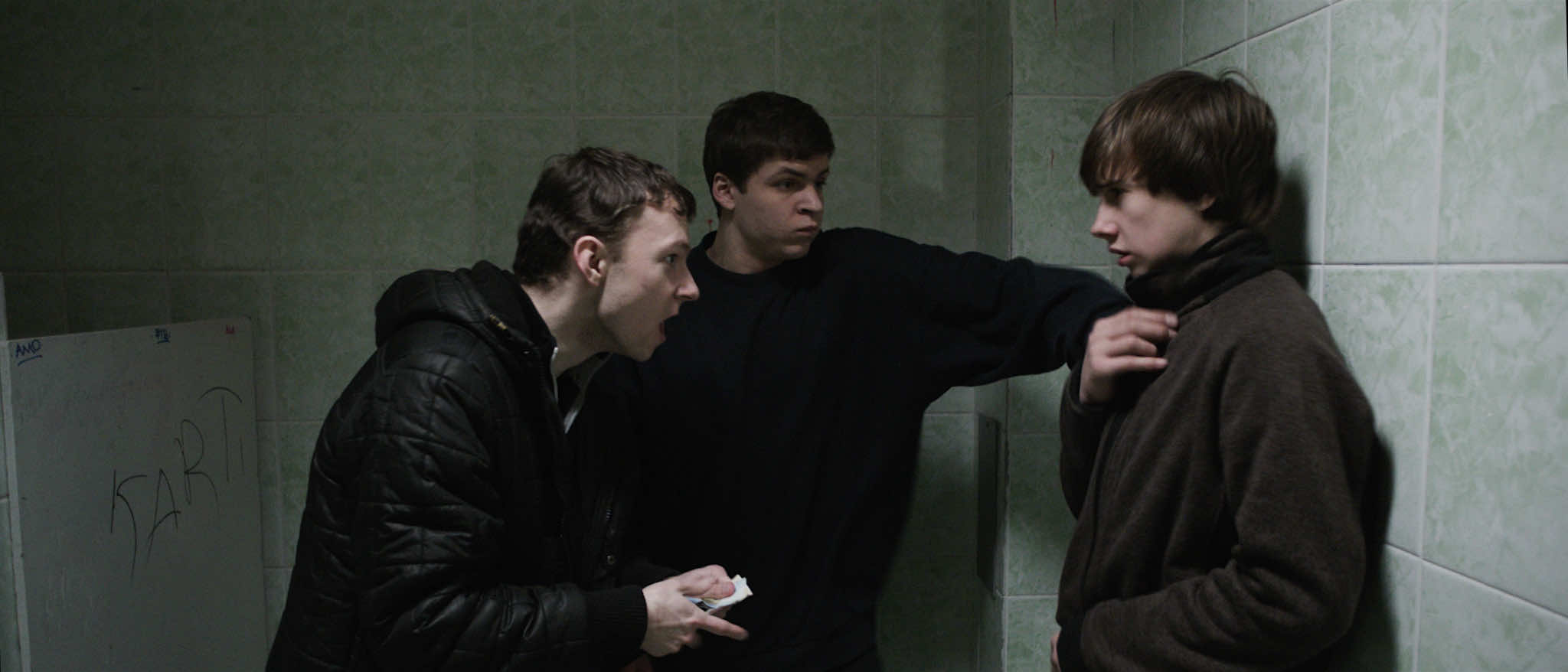Note: the Q&A with actress Yana Novikova below features frank talk about sex and may reveal plot spoilers. If you are offended by either, you might want to skip that part of the article.
The first ever deaf-led film from the Ukraine will not be an easy experience for anyone. The Tribe (Plemya) is concerned with teenagers who work for the country’s Deaf Mafia, a real thing, according to Ukrainian filmmaker Miroslav Slaboshpitsky. The writer/director was once a crime reporter in Kiev, and he has seen it all. It’s no wonder he doesn’t hold back when he presents the world of these kids with a distant camera that hardly ever blinks. The sex and violence is presented with an unflinching gaze, and it has rattled people the world over, as the film has collected many awards.
Speaking via Skype, Slaboshpitsky says he noticed something rather funny about the cultural differences of certain countries with how they reacted to either the film’s sex or violence. “The film is already released in 144 countries,” he says, “including the United States … We had this discussion with my French distributor. It received the rating of 16+ in France. It’s very big. I think 18+ … only 10 films per year receive this rating, but 16+ is not good. For example Blue is the Warmest Color has 13+ and my French distributor told me, ‘We have no problem with sex in your film, but violence was a problem for French audience, and this rating, 16+, can inform the audience it is a violent film, so for this reason we can lose some viewers.’ Anyway, we have a successful release in France, but I have the same with my American distributor, and he told me, the violence wasn’t the problem with the film, but the sex is. It’s very funny. It’s a different culture,” he adds with a laugh.
It took a special cast to put the film together and Slaboshpitsky spent about six months working on casting the film. He said he auditioned approximately 300 deaf people for the movie before settling on the bold group of actors that make up the teenagers of The Tribe. Of lead actor, Grigoriy Fesenko, he said he needed some patience before he could tap into the talent he saw from the start. “A friend of Grigoriy sent us his photo,” he reveals, “and I thought his look was very nice. Then he came to audition, and it was very tangible because Grigoriy is a real street guy. He is a parkourist. He has experience in street fighting and hooliganism and something like that. In the audition, he was so nervous he completely fucked up the whole audition. It interested me because it was a very interesting mix of the brutal street guy and … very, nervous … and I ask him to come to the audition again, and I asked him come again and finally we took him in the film.”
Meanwhile, the female lead, Yana Novikova, took the director by surprise. She stood out during an audition for someone else Slaboshpitsky was considering for the role. “Yana it was a very special story because I wasn’t sure about Yana before we started to shoot the movie,” he recalls, “so [the character] is a prostitute, and I’m looking for someone who is more sexy, much more Marilyn Monroe style, something like that. So I go to audition at a special deaf theater in Kiev, and Yana was one of the persons who tried to take part in this audition, and I’m coming to see the other girl, which really looks like a sex bomb. When I saw them doing all these different tasks for the audition, I didn’t notice this sex bomb anymore. Yana took all my attention. Finally, we invited her to rehearsal, and she really, really impressed me.”
To read more from Slaboshpitsky about the film, as well as Novikova, jump through the logo below for the Miami New Times’ Art and Culture blog:
Now, for those still here, below is my complete interview with Novikova. She responded to my questions via email which were translated for her and then translated back and sent to me. It was a lot of work for everyone involved, and she gave some long, intelligent and insightful responses, so I wanted to share the entire interview somewhere, and Independent Ethos is probably the best place for it. Note: this is also where the frank talk of sex and spoilers come in, including reference to an incident on set that would make for a funny blooper reel on the home video release were it not X-rated.
Hans Morgenstern: Your performance is incredibly powerful. Did you ever think you would become an actress? I read you have always dreamed of acting since childhood. What attracted you to it when you were a child?
Yana Novikova: I was 6 or 7 years old and I went with my mother to see “Titanic.” I loved Kate Winslet’s performance. I realized then that I wanted to become an actress, and what an interesting thing it is to do. It’s such a beautiful profession.
Which of the films the director showed you in preparation for your role did you like best and why:
Last Tango in Paris
La vie d’Adel (Blue is the Warmest Color)
9 Songs
Shortbus
Any of the films by Lars von Trier or Larry Clark or Pier Paolo Pasolini?
The director advised me to watch some good movies. I was most impressed with Blue is the Warmest Color. We saw it with the guys who also star in The Tribe. I was so impressed with the performance by the lead character. It is because of her performance in that film that I changed my attitude towards the role in The Tribe. I was no longer afraid.
Where did you find the courage to express yourself with such a demanding performance that includes nudity and violence?
After watching Blue is the Warmest Color I realized that working in cinema is art. Internally I was ready for it. The movie is not about nudity. This is a very profound film, and I came to its subject and depiction seriously. I rehearsed and worked on the role for a long time, trying to get used to the image of myself as a prostitute. When it was time to film the intimate scenes, I asked Myroslav to keep the set to a minimum number of people. So the only one’s present were the camera, sound and translator. Even Myroslav was in another room, watching at the monitor. I still do not feel comfortable about being naked in front of strangers, it is unnatural for me. And we had to do a lot of takes. I had a good understanding with my scene partner, and I did what I intuitively felt. This was not porn, the scenes have an aesthetic purity, there is feeling to them. These scenes are important to convey a sense of fullness, so that the audience believes and empathize with the hero. In some ways it’s like a cinematic representation of some of the great Renaissance art. For example, one of our scenes is very similar to the painting of Adam and Eve by Albrecht Durer.
There is a disturbing scene where you undergo an illegal “backroom” abortion. What was it like to shoot and how long did it take?
Myroslav prepared me well in advance that there would be a graphic abortion scene. I agreed immediately, but I was also worried about it, because I did not know how I should move or react like a real person might when having this procedure because I had never had one. The first day I was in rehearsal with Marina [Panivan], who played the woman performing the abortion. The second day we went to the director of a hospital, and we rehearsed in the hospital with a gynecologist. There was a special doll, a dummy, that they used to let doctors train on, so we could watch how it is done. The next day we filmed the scene, and it all turned out. And each time it was necessary to re-live the pain, to cry, to put forth the necessary emotion. In addition, I felt physical pain. The whole day I had to lay on that bare board, and by the end of filming that scene I was all cried out.
Though it is shocking movie, I’m sure you also must have enjoyed doing it. What did you enjoy most about making it? Was there anything that you didn’t enjoy so much about the shoot?
I like that the film is completely without subtitles and words. It seems to me that a deaf actor can convey more emotion than a hearing actor, because everything must be written on the face, all of the emotions: joy, sadness, hatred, resentment. Wherever we showed the film, viewers who hear all understood. Of course, when deaf audiences see it, they pay attention to the gestures, to what the characters say with their hands. But that’s not the signed dialogue, that is the emotions, because deaf foreigners who don’t understand International Sign are like hearing audiences forced to understand it from the emotions. When Myroslav explained to us what he needed us to do, he emphasized that the main thing was what emotions we give. If we forgot a word, he did not want us to worry, the main thing was to show emotion. It was okay to improvise, especially when there are gestures, not words. You do not need to hear dialogue when everything is written on the face, you can see all you need to in the movements. Because of that, The Tribe is truly a film for everyone. I like that.
Was there a fun moment you had on the set?
Yes, there was a funny moment where Myroslav said to me and Grigoriy that it was necessary to come up with a position we liked for a sex scene. I laughed, and I could not pick a position, then Myroslav came up with the “69” position, but I did not want to do “69,” and I wanted to choose something else. But Myroslav showed us the “69” position and how beautiful it looked, like how a “snake” moves. We were in rehearsal and we just could not be serious about this. We were laughing so hard, no one could keep from laughing about this.
Do you have any other roles lined up in the future?
I have received several offers for new films, and I hope to be working on a new project soon. I’m also planning to study in the U.S. and earn my masters in dramatic arts.
The Tribe opens in our South Florida area this Friday, July 24, at the Miami Beach Cinematheque and further north, in Broward County at the Cinema Paradiso Hollywood. It could already be playing in other locations across the U.S., if not coming soon. For other screening dates, visit this link and scroll down. The Miami Beach Cinematheque hosted a preview screening for the purpose of this article. All images are courtesy of Alamo Drafthouse.















